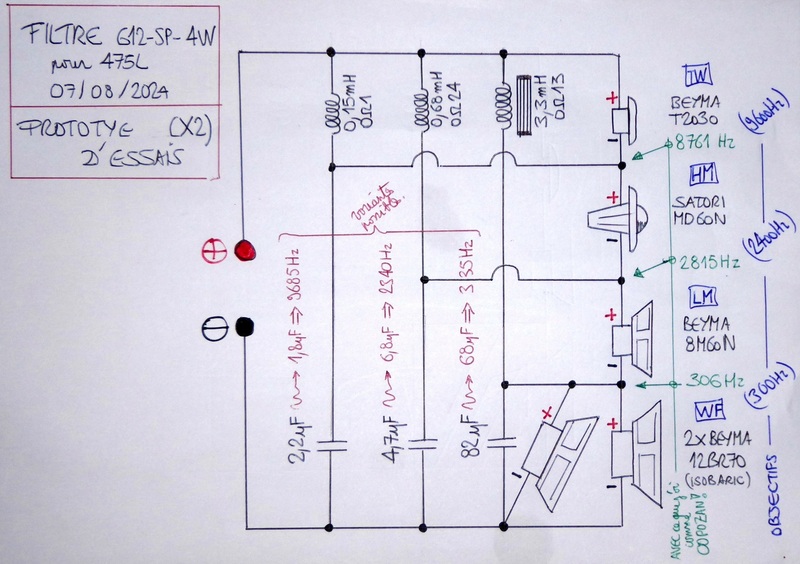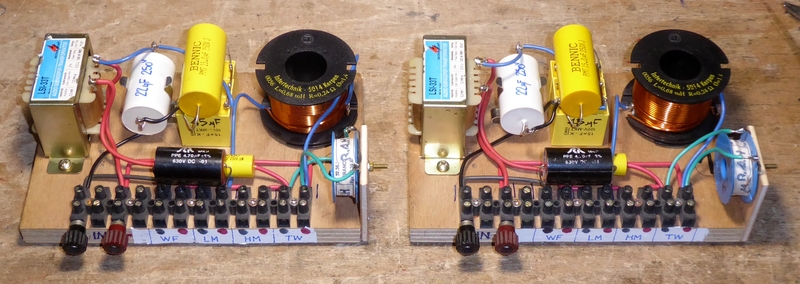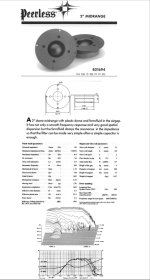I know it looks like I'm one of those purveyors of fluffy words and pixie dust, but it couldn't be any further from the case. I'm very lucky (and cursed) to have the hearing discernment I do. I can tell when something is put together and performing right and even moreso, when its wrong.@profiguy
It‘s hard for me to follow along with the whole false detail thing…….i find most folks that follow this mantra pray to the gods of sighted listening using FR as a road map. Measurements will only get you so far…..response, phase and impedance plots won’t tell you much with complex music…….the actual behavior of the transducer is nothing like a sweep or burst. At some point personal preference and subjectivity become the variable in the equation. By choice and occupation, I probably do more near field listening than most……..which is very enlightening over time. All transducers will exhibit some poor behavior under a specific condition…..end of the day, it’s still a motor.
Most people will run to measurement gear first and use it as a first line of detection. With speakers, my go to is recordings of spoken word and vocals (like Harbeth also does). For design work, I put little value in manufacturers data, specifically FR. Its never ever accurate because of several reasons, mainly due to so many variables affecting the consistent collection of data without much standards to remove those variables. CSD, stored energy and finally 3rd order harmonics are my primary pointers as to how suitable or well designed a specific driver is. I have my initial preferences and bias when it comes to TSP data on woofers, with specific ideals for various enclosure applications I prefer from a sound characteristic and best possible enclosure tuning to bring the most detail out of the lower end frequency spectrum. I hear the term "mode excitation" alot with low frequency tuning of rooms. There is temporal content detectable by our ears in low end frequencies under 100 hz. Its not just a bunch of fundamental sine waves detached from the music. Clean decay of separate notes and resonance suppression is critical to reproduce accurate bass that is connected harmonically AND temporally to the rest of the spectrum. The relative time domain needs to be preserved in the low frequencies as a whole in order for music to be reproduced accurately. In bass, pitch, amplitude and time must align.
Not everything is explainable with data. Some people are adamant any anomaly is detectable through measurement. I disagree. Measurements aren't the entire story and often are made under arbitrary conditions using methods which can result in deviating conclusions, specifically THD measurements. For example, if a driver suffers from low level VC rub and buzz, this isn't easy to detect without a clean test example to compare to. The ear can discern it though without a reference. I've had drivers with faintly audible rubbing VCs that have otherwise passed stringent QC measurements (Beyma, please take note... lol).
I’ve heard many drivers and combinations of them which sounded different than distortion data would suggest. The best example of this is the Silver Flute W20RC38 woofer - a very cheap driver that supposedly measures poorly distortion wise, but (based on my tests and implementation) sounds superb in quite a few ways to other much more expensive drivers of its type.
Then there's the opposite side of the argument, with most AMTs, that in most situations sound rough, harsh and aggressive when crossed under 2.5 - 3k. Above that, they typically sound very clean, analytical and extended. Sometimes the data suggested 3rd order HD peaks above several percent around the sub 3k mark. Often times there would be a clean CSD at lower SPL that would suddenly erupt into a sea of squiggles when the driver was pushed just a little further, suggesting non linear distortion behavior relative to rising SPL. Transient distortion is another phenomenon plaguing some planar drivers, which are sometimes traced back to localized resonances occurring in isolated sub-zones of the entire diaphragm area. This can sometimes be blamed on uneven diaphragm tensioning or tempering in localized spots of the diaphragm. The commonly resulting variation in performance is a known issue with many AMTs and planar drivers due to the mentioned manufacturing tolerances plaguing same model drivers, especially among the larger diaphragm models of budget brands. Even the higher end Mundorf AMTs suffer from these issues.
I genuinely understand the hesitation to count on the human ear being a measurement standard. Its an incredibly flawed notion. However, because there are still many things which are plainly audible to some people which cant be absolutely quantified or isolated by measurement gear, its very important not to exclude the ear as a diagnostic tool under certain conditions and situations. Alot of stuff can slip through the cracks when typical standard measurements and equipment are used to clear a given completed speaker or driver of potential faults. Having been a repair tech for all of my adulthood life has shown me there are still situations where a human being is required to determine specific faults or subtle traits of audio equipment. While human hearing is far from perfect, it still is the main deciding sense which judges the performance of audio equipment, specifically speakers. If it doesn't sound right, it won't be right.
I put little value in manufacturers data, specifically FR.
FR and CSD are just different sides of the same coin. A flat FR and rough CSD are mutually exclusive.CSD, stored energy and finally 3rd order harmonics are my primary pointers as to how suitable or well designed a specific driver is
@Boden FR can be flattened and will look good on paper, but the CSD will still have the same issues. FR can also be measured closer than 1m. There are quite a few drivers which show poor FR and have rather clean CSD. Just applying alot of smoothing and changing the scale can really skew the impression on both measurments. Only with CSD and multi angle FR (along with stored energy and impulse response) can you determine the purpose and usefulness of a given driver, but again that can be manipulated in favor of the manufacturer.
FR and CSD are just different sides of the same coin. A flat FR and rough CSD are mutually exclusive.
Oh, really?
These were used in quite a few higher end speakers in Europe. They even made a horn loaded version with a phase plug. They also had a chambered version and one without.Look very much like peerless 2" silk domes from the 1990ies
Attachments
Do you think it works well with the Focal TC 120 TD5? Morel MDT32S is the preferred replacement to the DynAudio D-21 originals according to Madisound. The Focals sound good but I am wondering if I should keep an eye out for the Morel's?These were used in quite a few higher end speakers in Europe.
@himey You can buy NOS Dynaudio D21/2 at Solen for $100 each.
https://solen.ca/en/products/dynaudio-d21-2-21mm-silk-dome-tweeter-8ohm-NOS
They still have a bunch. For that price, I'd say its worth it. If you want the more refined tweeter, I'd go for the Morel MDT32S, but it doesn't have the top end extension of the D21/2
https://solen.ca/en/products/dynaudio-d21-2-21mm-silk-dome-tweeter-8ohm-NOS
They still have a bunch. For that price, I'd say its worth it. If you want the more refined tweeter, I'd go for the Morel MDT32S, but it doesn't have the top end extension of the D21/2
I have heard that they are easy to blow and I have them in a large open room. I listen very loud at times. I am going to try another tweeter but I am going to try to hold off on the originals although I could change my mind later today. I am very tempted!You can buy NOS Dynaudio D21/2 at Solen for $100 each.
Just cross them high enough to not push them into overexcursion. They don't have very flexible lead wires and often die because of fracturing the lead wires.
When I see this :

I think that I am not the craziest with only 4-ways :

😆😆😆😉
@himey : would you tell me which model of JSE speaker it is, so I could find more information on them ?
T
I think that I am not the craziest with only 4-ways :
😆😆😆😉
@himey : would you tell me which model of JSE speaker it is, so I could find more information on them ?
T
You know what they say, don't you?....
2.ways... = 2 problems
3 ways... = 3 problems
4 ways... = 4 problems
I can't imagine how much overlap there is on a 5 way speaker with a passive network. You almost need another filler driver for the filler driver. At least they don't call midrange drivers "squawkers" anymore. Now there's an appropriate definition for the little satellite cubes on Bose lifestyle systems.
2.ways... = 2 problems
3 ways... = 3 problems
4 ways... = 4 problems
I can't imagine how much overlap there is on a 5 way speaker with a passive network. You almost need another filler driver for the filler driver. At least they don't call midrange drivers "squawkers" anymore. Now there's an appropriate definition for the little satellite cubes on Bose lifestyle systems.
You know what they say, don't you?....
2.ways... = 2 problems
3 ways... = 3 problems
4 ways... = 4 problems
I can't imagine how much overlap there is on a 5 way speaker with a passive network. You almost need another filler driver for the filler driver. At least they don't call midrange drivers "squawkers" anymore. Now there's an appropriate definition for the little satellite cubes on Bose lifestyle systems.
Ha ! NO ways... = NO problems ! 🤔😆
S'il n'y a pas de solutions, c'est qu'il n'y a pas de problème (Jacques Rouxel / Les Shadoks / 1969)
@tubelectron Those look like Beyma chassis at a quick glance.
Exactly, good guess ! From Top to Bottom :
TW = BEYMA T2030
HM = SATORI MD60N (we interestingly discussed about it in the thread, @profiguy 😎 )
LM = BEYMA 8M60N
WF = 2X BEYMA 12BR70 in Isobaric configuration.
Serial/Parallel crossover "612SP-4W" (prototype setup for tests) :


I am very far from the Infinite Slope Model 2 crossover ! 😱
Very Good... Thanks @himey ! 😎
T
Last edited:
Your driver is far from flat to start with. I have no clue what you try to demonstrate with these strange measurements.Oh, really?
Your driver is far from flat to start with. I have no clue what you try to demonstrate with these strange measurements.
Exactly! Where are the long decay ridges?
One of the major, maybe most important, benefits of 4-way systems is to leave the 1 - 4 kHz presence band unfiltered, which you could easily do with your choice of speaker units.TW = BEYMA T2030
HM = SATORI MD60N (we interestingly discussed about it in the thread, @profiguy 😎 )
LM = BEYMA 8M60N
WF = 2X BEYMA 12BR70 in Isobaric configuration.
Serial/Parallel crossover "612SP-4W" (prototype setup for tests) :
So the ~ 2k5 crossover frequency between 8M60N and MD60N seems odd.
Also, you will have unbalanced DI.
@tubelectron i really like Jacques Rouxel. He was a really funny guy. I have a storyboard signed by him I got from my parents.
I had a pair of 4 ohm versions of these plastic domes. In my juvenile enthusiasm I very violently drilled the pole pieces to add back chambers. They still worked but I gave up on them after the ferrofluid apparently went bad and 2" domes were not fashionable anymore.These were used in quite a few higher end speakers in Europe.
I think at one point I just threw them away ... what a loss!
@stv I'm pretty sure we all did something like that at least once ourselves. I had a pair of those Cabasse 12" wool cone woofers with the 3 spoke basket and thought it would be great to coat the cones with PVA... wah wah wah... that was a massive fail. Then I decided to clean the dust from the surround on my Fostex FW305s with a vacuum cleaner of unknown power and sucked the whole surround off the speaker in one big poof...needless to say, I don't have a good track record dealing with vintage 12" woofers.
- Home
- Loudspeakers
- Multi-Way
- The dome midrange thread
